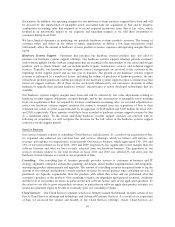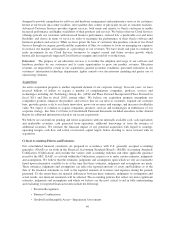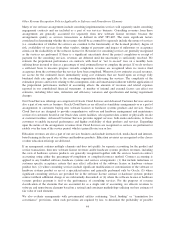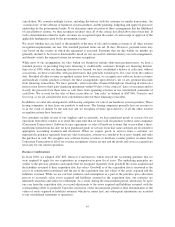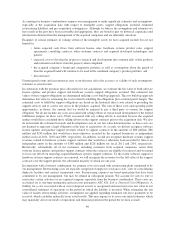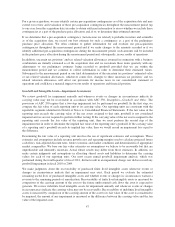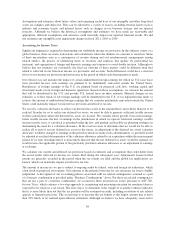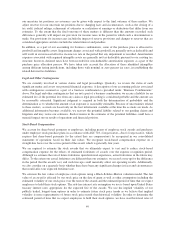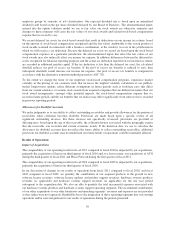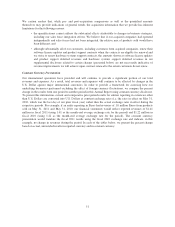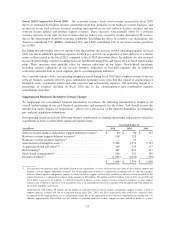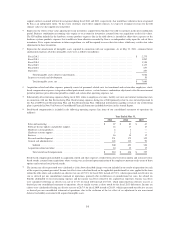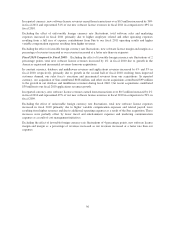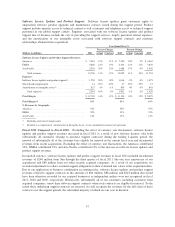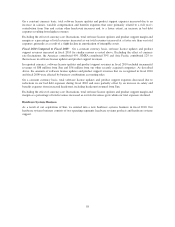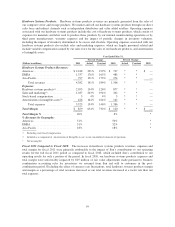Oracle 2011 Annual Report Download - page 51
Download and view the complete annual report
Please find page 51 of the 2011 Oracle annual report below. You can navigate through the pages in the report by either clicking on the pages listed below, or by using the keyword search tool below to find specific information within the annual report.our uncertain tax positions, no assurance can be given with respect to the final outcome of these matters. We
adjust reserves for our uncertain tax positions due to changing facts and circumstances, such as the closing of a
tax audit, judicial rulings, refinement of estimates or realization of earnings or deductions that differ from our
estimates. To the extent that the final outcome of these matters is different than the amounts recorded, such
differences generally will impact our provision for income taxes in the period in which such a determination is
made. Our provisions for income taxes include the impact of reserve provisions and changes to reserves that are
considered appropriate and also include the related interest and penalties.
In addition, as a part of our accounting for business combinations, some of the purchase price is allocated to
goodwill and intangible assets. Impairment charges associated with goodwill are generally not tax deductible and
will result in an increased effective income tax rate in the period that any impairment is recorded. Amortization
expenses associated with acquired intangible assets are generally not tax deductible pursuant to our existing tax
structure; however, deferred taxes have been recorded for non-deductible amortization expenses as a part of the
purchase price allocation process. We have taken into account the allocation of these identified intangibles
among different taxing jurisdictions, including those with nominal or zero percent tax rates, in establishing the
related deferred tax liabilities.
Legal and Other Contingencies
We are currently involved in various claims and legal proceedings. Quarterly, we review the status of each
significant matter and assess our potential financial exposure. A description of our accounting policies associated
with contingencies assumed as a part of a business combination is provided under “Business Combinations”
above. For legal and other contingencies that are not a part of a business combination, we accrue a liability for an
estimated loss if the potential loss from any claim or legal proceeding is considered probable and the amount can
be reasonably estimated. Significant judgment is required in both the determination of probability and the
determination as to whether the amount of an exposure is reasonably estimable. Because of uncertainties related
to these matters, accruals are based only on the best information available at the time the accruals are made. As
additional information becomes available, we reassess the potential liability related to our pending claims and
litigation and may revise our estimates. Such revisions in the estimates of the potential liabilities could have a
material impact on our results of operations and financial position.
Stock-Based Compensation
We account for share-based payments to employees, including grants of employee stock awards and purchases
under employee stock purchase plans in accordance with ASC 718, Compensation—Stock Compensation, which
requires that share-based payments (to the extent they are compensatory) be recognized in our consolidated
statements of operations based on their fair values. We recognize stock-based compensation expense on a
straight-line basis over the service period of the award, which is generally four years.
We are required to estimate the stock awards that we ultimately expect to vest and to reduce stock-based
compensation expense for the effects of estimated forfeitures of awards over the expense recognition period.
Although we estimate the rate of future forfeitures upon historical experience, actual forfeitures in the future may
differ. To the extent our actual forfeitures are different than our estimates, we record a true-up for the difference
in the period that the awards vest, and such true-ups could materially affect our operating results. Additionally,
we also consider on a quarterly basis whether there have been any significant changes in facts and circumstances
that would affect our expected forfeiture rate.
We estimate the fair values of employee stock options using a Black-Scholes-Merton valuation model. The fair
value of an award is affected by our stock price on the date of grant as well as other assumptions including the
estimated volatility of our stock price over the term of the awards and the estimated period of time that we expect
employees to hold their stock options. The risk-free interest rate assumption we use is based upon United States
treasury interest rates appropriate for the expected life of the awards. We use the implied volatility of our
publicly traded, longest-term options in order to estimate future stock price trends as we believe that implied
volatility is more representative of future stock price trends than historical volatility. In order to determine the
estimated period of time that we expect employees to hold their stock options, we have used historical rates of
49


